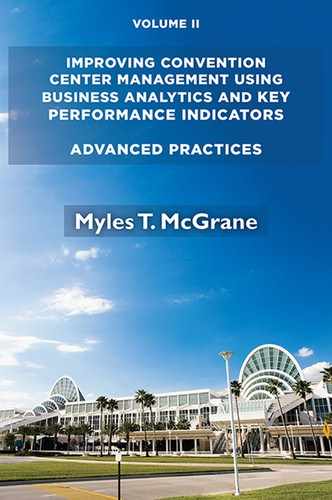KPI: Water Use Per Thousand GSF Rented (KGSF)
Owner |
Sustainability Manager or Facilities Department |
Data Sources and Collection |
Water use (per 100 gals or in hundreds of cubic feet) can be obtained from the water bills. Either the Finance Department or the Facilities Department should be responsible for keeping these records. If the water company is a city department, then the billing frequency may not be on a monthly basis and is often quarterly, semi- annually, or on irregular schedule. In these cases, you may elect to read the water meter on a regular schedule. KGSF can be obtained from the Sales Department. |
Reporting Frequency |
Quarterly or semi-annually |
Why This KPI Is Useful
Water is a relatively inexpensive in water rich states and very expensive in states with limited resources. A water conservation program is a necessity for convention centers in states with limited water resources. In states where droughts are more frequent and severe, a more thoughtful and aggressive conservation program is also necessary to enable the center to operate without disrupting events or inconveniencing event attendees.
For some perspective, an IAVM report on Green Meetings estimated the average conference delegate uses 846 gallons of water, or roughly 262 gallons per day. Regular home use of water by the average American amounts to about 86 gallons per day.
Objective
Decrease water use as much as practical and affordable (without adversely affecting customer service) through best practices and water-saving investments.
Managing Unfavorable Conclusions and inferences
Typical investments are leak-detecting sensors and low flow sink faucets and toilets. Some convention centers have built infrastructure to capture and store storm water and use it for site irrigation.
How to Calculate and/or Organize Data
1. To best determine water use efficiency, develop water use and profile for a baseline year (a three- to five-year average) for water consumed per KGSF.
2. Follow the calculation instructions in the Work Sheet 9.1.
BASELINE WATER USE EFFICIENCT |
|||
WATER USE |
CCF |
KGSF Rented |
CCF per KGSF Rented |
1st Qtr. |
48,000 |
5,838 |
8.2 |
2nd Qtr. |
56,950 |
6,436 |
8.8 |
TOTAL |
104,950 |
12,274 |
8.6 |
CURRENT WATER USE EFFICIENCY |
|||
WATER USE |
CCF |
KGSF Rented |
CCF per KGSF Rented |
1st Qtr. |
34,050 |
5,984 |
5.7 |
2nd Qtr. |
49,500 |
6,533 |
7.6 |
TOTAL |
83,550 |
12,517 |
6.7 |
SAVINGS DUE TO CHANGE IN EFFICIENCY (3.4%) |
|||
CCF Saved |
Price/CCF |
$ Avoided/Saved |
|
23,478 |
$2.15 |
$505 |
|
Gals. Saved |
|||
17,514,435 |
|||
Work Sheet 9.1 Water use efficiency
Calculation Instructions:
1. To calculate the water saved in hundreds of cubic feet (CCF), multiply the KGSF for the current year by the baseline year CCF per KGSF Rented and then subtract the product by current year’s total water use.
2. To calculate gallons of water saved, multiply CCF Saved by 748 (there are 748 gallons of water per CCF).
Presentation Format
Table, bar graph, or both comparing current YTD, previous YTD and business plan.
KPI: Report on Sustainability Initiatives
Owner |
Sustainability Manager |
Data Sources and Collection |
The Sustainability Manager should compose an interesting narrative of each initiative and keep a record of measureable results. |
Reporting Frequency |
Semi-annually |
Why This KPI Is Useful
A series of progress reports on sustainability initiatives will be interesting and well read. Sustainability initiatives are good topics to include as content for enhancing your center’s social media presence.
Convention centers are excellent demonstration sites or laboratories for promoting viable sustainability. They are highly visible to businesspeople, media, professionals, and interested public who may be attending or exhibiting at events. Below are examples of sustainability initiatives worth tracking and reporting:
• On-site generation of electricity though solar or wind power.
• On-site storage of electricity produced with renewable energy.
• Green roofs and other natural settings on the property. Convention centers have two outstanding demonstrations of green roofs at the Vancouver Convention and Exhibition Centre and the Javits Center.
• Reduction of plastic throw away bottles.
• Compostable food packaging.
• On-site food production (herb gardens, vegetables, mini orchards).
• On-site display of electric cars (ideally through an automobile company sponsorship).
• Recharging stations in parking areas for electric vehicles.
Objective
Engage in as many viable sustainability initiatives as practical. Initiatives are viable in the sense that the initiatives are new and emerging technologies, methods, and practices that may serve as visible working examples and speed commercialization. At some point, if the initiative or project is commercial viability it may qualify for further investment.
Managing Unfavorable Conclusions and Inferences
This KPI should be active with new data and information all the time. Presently the list of new initiatives is plentiful. If inactive, have a serious discussion with the center’s Sustainability Manager.
How to Calculate and/or Organize Data
No calculations are necessary other than converting units of measure into pounds or tons of CO2.
Presentation Notes and Formats
The presentation format should be a brief narrative of progress, possibly with photos and preliminary results of savings, carbon footprint reduction, return on investment, and so on.
